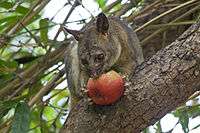Northern brushtail possum
| Northern brushtail possum[1] | |
|---|---|
| Trichosurus arnhemensis | |
Not evaluated (IUCN 3.1) | |
| Scientific classification | |
| Kingdom: | Animalia |
| Phylum: | Chordata |
| Class: | Mammalia |
| Infraclass: | Marsupialia |
| Order: | Diprotodontia |
| Family: | Phalangeridae |
| Genus: | Trichosurus |
| Species: | T. arnhemensis |
| Binomial name | |
| Trichosurus arnhemensis Collett, 1897 | |

The Northern brushtail possum (Trichosurus arnhemensis) is a nocturnal marsupial inhabiting northern Australia. It is closely related to the Short-eared possum, Mountain brushtail possum, Coppery brushtail possum, and the Common brushtail possum, the other four species of its genus.[1]
Lifestyle
Are nocturnal in nature and so feed between dawn and dusk. They are territorial creatures and can be found alone or in family groups.[2]
Appearance
Its fur is a grey in colour, with a white underbelly and pink skin. The Northern brushtail possum can grow up to 55 cm (22 in) in length, not including its tail, and are around the size of a small cat. Unlike its relatives and despite what its name suggests, the Northern brushtail possum does not have a bushy tail.[3][4]

Lifespan and reproduction
The Northern brushtail possum breeds year-round, with a gestation period of around 17–18 days and pouch period of 4–5 months. It can live for up to 15 years.
Diseases
Many of the NT possums are found to have contracted a flesh eating bacteria. This causes their faces to be eaten away and often results in blindness.The disease has been widely spread within the possum community, also affecting Ringtail possums. Possums brought into the local RSPCA after contracting the disease are commonly put down. Once the possums contract the sickness they are often found to be more welcoming to humans, and will approach when practical.[5]

Relationship with humans
The Northern brushtail possum is well adapted to rural and urban areas and is sometimes considered a pest in high numbers.[4] Like other possums, it is rather tolerant of humans and can sometimes be hand-fed, although it is not encouraged as their claws are quite sharp and can cause infection or disease to humans if scratched. It is a traditional food source for some indigenous Australians.[6]
Diet
The Northern brushtail possum eats a variety of plant matter, including fruit, leaves, flowers and seeds.[3] Brushtail Possums are known to be tolerant of many plant toxins and will eat trees that other animals find poisonous. Possums will also eat insects, moths, grubs snails, birds’ eggs and babies. Many of the possums favourite diets are unfortunately found in domestic gardens, drawing the possums into residential yards.[2]
References
| Wikimedia Commons has media related to Trichosurus arnhemensis. |
| Wikispecies has information related to Trichosurus arnhemensis |
- 1 2 Groves, C.P. (2005). Wilson, D.E.; Reeder, D.M., eds. Mammal Species of the World: A Taxonomic and Geographic Reference (3rd ed.). Baltimore: Johns Hopkins University Press. ISBN 0-801-88221-4. OCLC 62265494.
- 1 2 "Top 10 Facts About Possums in Australia | Bird Gard Australia". Bird Gard Australia. 12 February 2015.
- 1 2 Milich, K. (2002). "Trichosurus arnhemensis". Animal Diversity Web. Retrieved 2008-04-18.
- 1 2 Cleaver, B. "The Brushtail Possum (Trichosurus vulpecula)". The Marsupial Society of Australia. Retrieved 2008-04-18.
- ↑ "Skin disease is killing possums". Courier Mail.
- ↑ "Food database". NineMSN. Retrieved 2008-04-18.